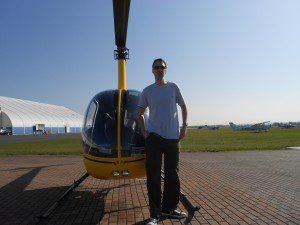 I always suggest to my students that they should get their exam day off to a really confident start by becoming totally fluent at preparing and giving a MATED brief. First impressions are everything, and the MATED brief will give the start to your day some structure and pace. Ask friends, or fellow students to sit and listen while you do it until it’s very familiar. The checklist (linked at the end of this article) also prompts you to get everything ready in the right order on the day, leading up to the MATED brief itself. The standards document from the CAA is also linked below, and you should be really familiar with it. Your day will feel much less stressful if you remove as many unknowns as possible, which should include knowing exactly how the day will go, which aircraft your in, and being familiar with the documents in its file so you’re you don’t look as though you’ve never seen them before.
I always suggest to my students that they should get their exam day off to a really confident start by becoming totally fluent at preparing and giving a MATED brief. First impressions are everything, and the MATED brief will give the start to your day some structure and pace. Ask friends, or fellow students to sit and listen while you do it until it’s very familiar. The checklist (linked at the end of this article) also prompts you to get everything ready in the right order on the day, leading up to the MATED brief itself. The standards document from the CAA is also linked below, and you should be really familiar with it. Your day will feel much less stressful if you remove as many unknowns as possible, which should include knowing exactly how the day will go, which aircraft your in, and being familiar with the documents in its file so you’re you don’t look as though you’ve never seen them before.
Your school should make sure that the weather decision (to go or not to go) has been made the day before, and confirmed on the morning of your test. Listen to their advice, but ultimately it’s your decision. If everyone is saying it’s marginal, you are entitled to say you’d rather have a better than marginal day, and to postpone.
So, after introductions and a briefing by the examiner on his/her expectations for the day, expect to receive the details of your navigation task, and to sit down in a quiet room to prepare. Just before you do, ask your Examiner for his/her weight. Prepare your route, and double check everything, especially the wind/heading calculations. From this you’ll get a fuel requirement, and from this you can do a weight and balance. Then, really importantly, rehearse the route in your mind. Get to a point where you know what to expect, e.g.: Fly west until I get to Newtown, then turn south along the river, all the time keeping the big lake in sight. This will give you confidence about not getting lost.
Now comes the MATED brief. Give the brief, answer any questions, and go out determined to fly what you have just briefed.
At the helicopter, show a detailed knowledge in your pre-flight check. Remember there’s nothing in the flight manual that says you don’t do a full check before every flight. Make sure that if a component is mentioned in the checklist, you can point to it on the helicopter. This is particularly applicable to the main rotor head, where there are lots of things like horns, tusks, stops, yokes and scissors that don’t readily suggest what they are from their names. Make sure you know about the lines drawn by engineers on the telatemps. There are lines drawn on yours, right?
By the time you go flying, your Examiner should have a pretty good idea that you are knowledgable and well trained, which is a big help.
Before take-off, remember your pre-take-off checks, said loudly, confidently and fluently (ie learn this as you would learn a poem) e.g.: “Lights Revs Map Lights Ts Ps Keys Carb heat, clear your side? clear mine”.
Remember to do a power check in the hover after take-off, and say it out loud, eg: “Hovering 22 inches, so I have 2.4 inches in hand”.
In flight, remember your FREDA checks, even if workload is high. I recommend doing them every time you’re settled down on a new leg, and every time you pass a half way point, and when you call for rejoin. Try to be fluent with your checks, by learning off by heart when you’re not flying, a form of words that you can use when you are, e.g.:
“Fuel is on and adequate,
Radio set and working,
Engine: Lights Revs Map Lights Ts Ps Keys Carb heat,
DI is set,
Altimeter is set”.
Say them out loud, again fluently and confidently, as part of making it look as if you are comfortable as pilot in command. Obviously make sure you are checking the stuff as well as saying it.
When you’re on the dead reckoning leg, settle on your height and heading, then look up and find a point on the horizon in that heading and steer for it. That will unload your cockpit workload, which in turn makes the rest of your nav better.
Keep your Examiner in the picture about what you’re doing and what you’re planning to do. Even if you’re lost, or if you want to do something again. We all sometimes get an approach wrong or go off course a little. The good pilot notices, declares the problem, and flags up what he/she intends to do to correct it.
Don’t lose height or speed or heading, when you’re distracted. Remember it’s Aviate, Navigate, Communicate.
Landings: Keep your nerve. Think if it as a series of lower and lower hovers!
Remember to log both of your datcon readings, and your start/shutdown times.